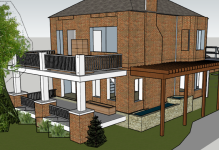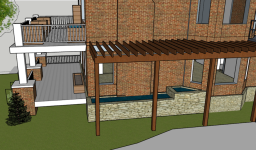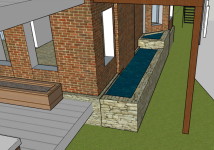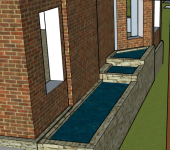- Joined
- Jan 29, 2022
- Messages
- 4
- Reaction score
- 4
- Country

Hello everyone,
First time poster here. This website seems to have a lot of good information. I'm a DIY homebuilder who is designing a pond against the brick on the southern side of the house and I wanted to run my plan by all of you and see your thoughts. I've attached some sketches of the situation to help you visualize my plans. I thank you in advance for your time and experience.
The idea:
The point of the pond is for rainwater catchment, protein/fertilizer production, and to add significant thermal mass to the southern side of my house. Ohio has some brutal summers AND winters and I'm hoping I can temper them a little bit. I'm planning on building a pergola over the pond and using it as a trellis for grapes to give the pond a respite from the July sun. The pond will be powered with a solar-panel on the pergola and a submersible pump. A voided bog filter/waterfall will provide filtration and oxygenation to the pond. The pond will be lightly stocked with bluegill and minnows until it matures. Longterm I would like Koi.
Construction:
I'm torn on how to build the envelope and how much I should dig out the bottom. Currently I'm thinking of digging a concrete footer and building a concrete block wall on top of it. Then I would shape the walls with clay or sand and use a pond liner to make it water tight. I can dig the deep part of the pond as deep as I would like because my house has a basement and the house footer is about 6' deep. I haven't decided how deep I should make the dugout.
Questions:
What is the optimum depth for a long narrow pond? I'm worried about freezing and boiling my fish.
Do I need to construct a back wall for the pond, or can I rely on my existing brick wall? The house is old and sturdy and the brick is at least a foot thick. Also, I only have a three-foot width to work with including the thickness of the wall. Also, I haven't worked out how to "lip" the edge for the back wall and attach the liner.
Do I need to add pavers as a "splash-guard" for my brick? I'm not sure how much moisture is dangerous.
Should I consider building the pond completely out of concrete? I like the idea of block and liner because it could be removed in an emergency, but I'm open to ideas.
How deep should I make my "Bog Pond"? I will have basket full of gravel on top that is only 3" thick or so to house my plants. I will set this on top of milk crates. Is there a benefit to having a deeper void under the basket? Could I fill this void with plastic media or maybe grow clams or crustaceans underneath?
I'm really excited for the project. Thank you in advance for all your help!
First time poster here. This website seems to have a lot of good information. I'm a DIY homebuilder who is designing a pond against the brick on the southern side of the house and I wanted to run my plan by all of you and see your thoughts. I've attached some sketches of the situation to help you visualize my plans. I thank you in advance for your time and experience.
The idea:
The point of the pond is for rainwater catchment, protein/fertilizer production, and to add significant thermal mass to the southern side of my house. Ohio has some brutal summers AND winters and I'm hoping I can temper them a little bit. I'm planning on building a pergola over the pond and using it as a trellis for grapes to give the pond a respite from the July sun. The pond will be powered with a solar-panel on the pergola and a submersible pump. A voided bog filter/waterfall will provide filtration and oxygenation to the pond. The pond will be lightly stocked with bluegill and minnows until it matures. Longterm I would like Koi.
Construction:
I'm torn on how to build the envelope and how much I should dig out the bottom. Currently I'm thinking of digging a concrete footer and building a concrete block wall on top of it. Then I would shape the walls with clay or sand and use a pond liner to make it water tight. I can dig the deep part of the pond as deep as I would like because my house has a basement and the house footer is about 6' deep. I haven't decided how deep I should make the dugout.
Questions:
What is the optimum depth for a long narrow pond? I'm worried about freezing and boiling my fish.
Do I need to construct a back wall for the pond, or can I rely on my existing brick wall? The house is old and sturdy and the brick is at least a foot thick. Also, I only have a three-foot width to work with including the thickness of the wall. Also, I haven't worked out how to "lip" the edge for the back wall and attach the liner.
Do I need to add pavers as a "splash-guard" for my brick? I'm not sure how much moisture is dangerous.
Should I consider building the pond completely out of concrete? I like the idea of block and liner because it could be removed in an emergency, but I'm open to ideas.
How deep should I make my "Bog Pond"? I will have basket full of gravel on top that is only 3" thick or so to house my plants. I will set this on top of milk crates. Is there a benefit to having a deeper void under the basket? Could I fill this void with plastic media or maybe grow clams or crustaceans underneath?
I'm really excited for the project. Thank you in advance for all your help!




